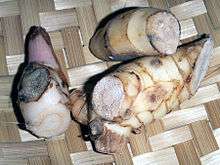Alpinia galanga
| Alpinia galanga | |
|---|---|
 | |
| Scientific classification | |
| Kingdom: | Plantae |
| Clade: | Angiosperms |
| Clade: | Monocots |
| Clade: | Commelinids |
| Order: | Zingiberales |
| Family: | Zingiberaceae |
| Genus: | Alpinia |
| Species: | A. galanga |
| Binomial name | |
| Alpinia galanga | |

Alpinia galanga (also Languas galanga),[1] a plant in the ginger family, is an herb used in cooking, especially in Indonesian and Thai cuisines. It is one of four plants known as galangal and is differentiated from the others with the common name greater galangal (or simply Thai galangal). The galangals are also called blue ginger or Thai ginger.
Alpinia galanga is called laos in Indonesian and is the most common form of galangal used in cooking. It is also known as lengkuas and galanga root. In the Philippines, it is known as langkawas. In Manipuri, it is known as kanghu. In Myanmar, it is called pa de kaw (ပတဲေကာ). In Cambodia, it is called romdeng (រំដេង).
Description

The plant grows from rhizomes in clumps of stiff stalks up to 2 m in height with abundant long leaves that bear red fruit. It is native to South Asia and Indonesia and cultivated in Malaysia, Laos, and Thailand. A. galanga is the galangal used most often in cookery. The robust rhizome has a sharp, sweet taste and smells like a blend of black pepper and pine needles. The red fruit is used in traditional Chinese medicine and has a flavor similar to cardamom.
Culinary uses
The rhizome is a common ingredient in Thai curries and soups, where it is used fresh in chunks or cut into thin slices, mashed and mixed into curry paste. Indonesian rendang is usually spiced with galangal.
Traditional medicine
_Willd.jpg)
Under the names 'chewing John', 'little John to chew', and 'court case root', it is used in African American folk medicine and hoodoo folk magic. Ayurveda considers A. galanga (Sanskrit:-rasna) as a Vata Shamana drug. Known as பேரரத்தை (perarathai) in Tamil, this form of ginger is used with licorice root, called in Tamil athi-mathuram (Glycyrrhiza glabra) as folk medicine for colds and sore throats.
Potential pharmacology
The rhizome has been shown to have weak antimalarial activity in mice.[2]
Chemical constituents
Alpinia galanga rhizome contains the flavonol galangin.[3]
The rhizome contains an oil, known as galangol, which upon fractional distillation produces cineol, which has medicinal properties, pinene and eugenol, among others.[4]
See also
References
- ↑ Duke, James A.; Bogenschutz-Godwin, Mary Jo; duCellier, Judi; Peggy-Ann K. Duke (2002). Handbook of Medicinal Herbs (2nd ed.). Boca Raton, Florida: CRC Press. p. 350. ISBN 0-8493-1284-1. Retrieved 1 March 2011.
- ↑ Al-Adhroey, Abdulelah H.; Nor, Zurainee M.; Al-Mekhlafi, Hesham M.; Mahmud, Rohela (2010). "Median Lethal Dose, Antimalarial Activity, Phytochemical Screening and Radical Scavenging of Methanolic Languas galanga Rhizome Extract". Molecules. 15 (11): 8366–76. doi:10.3390/molecules15118366. PMID 21081857.
- ↑ Kaur, A; Singh, R; Dey, CS; Sharma, SS; Bhutani, KK; Singh, IP (2010). "Antileishmanial phenylpropanoids from Alpinia galanga (Linn.) Willd". Indian journal of experimental biology. 48 (3): 314–7. PMID 21046987.
- ↑ Rasadah Mat Ali; Zainon Abu Samah; Nik Musaadah Mustapha; Norhara Hussein (2010). ASEAN Herbal and Medicinal Plants (PDF). Association of Southeast Asian Nations. p. 29. ISBN 978-979-3496-92-4. Archived (PDF) from the original on 12 June 2017.
Further reading
- Greater galangal
- Scheffer, J.J.C. & Jansen, P.C.M., 1999. Alpinia galanga (L.) Willd.[Internet] Record from Proseabase. de Guzman, C.C. and Siemonsma, J.S. (Editors). PROSEA (Plant Resources of South-East Asia) Foundation, Bogor, Indonesia.
External links
| Wikispecies has information related to Alpinia galanga |
- Alpinia galanga (L.) Willd. Medicinal Plant Images Database (School of Chinese Medicine, Hong Kong Baptist University) (in traditional Chinese) (in English)